
Here’s our take on the 50 most important people
in the last 50 years of technical innovation.
by Christopher Null, IDG
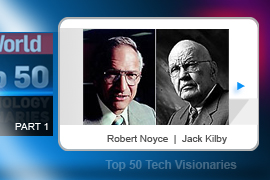
Jack Kilby and Robert Noyce
Robert Noyce (left) and Jack Kilby didn’t work together, but their common invention is still utterly crucial. In 1959, both men came up with the first integrated circuits — Kilby while he was at Texas Instruments, and Noyce at Fairchild Semiconductor.
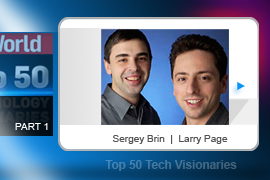
Sergey Brin and Larry Page
Larry Page (left) and Sergey Brin founded Google, the search engine turned single most important business in Silicon Valley today. The rapidly expanding Google universe now offers dozens of productivity and entertainment tools — from word processing to video — most of them free, underwritten by the company’s ubiquitous ad-serving system.
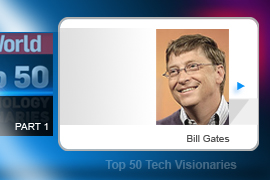
Bill Gates
The world’s richest man dropped out of Harvard 30 years ago to launch Microsoft with Paul Allen. A seemingly unassuming geek who proved to be a formidable businessman, Bill Gates built his empire on a deal to provide IBM an OS they bought from a third party.
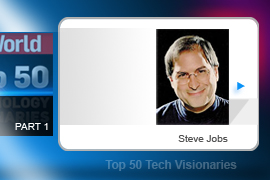
Steve Jobs
The once and future King of Apple, Steve Jobs is familiar to even the most casual technophile. Jobs lays claim to two critical moments in tech history: the creation of the original Apples, and convincing the world that people ought to carry their (digital) music with them everywhere they go.

Tim Berners-Lee
You wouldn’t be reading this if not for Tim Berners-Lee and his 1989 invention, the World Wide Web. Everything from URL structure to hyperlinks were part of his original specifications.
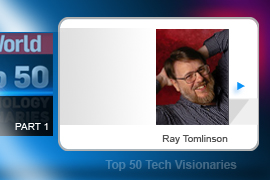
Ray Tomlinson
In 1971 Ray Tomlinson sent the message that would ultimately be heard ’round the world: An e-mail from one ARPANet host to another. Tomlinson also came up with the idea of using the @ symbol to separate the username from the host name in an e-mail address.
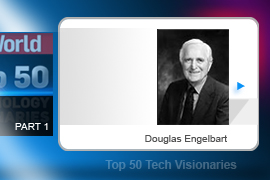
Douglas Engelbart
Engelbart patented the idea of his “X-Y position indicator for a display system” in 1967, and also nicknamed the device the mouse (owing to its tail). He and his research lab also developed an early online storage system — and even demonstrated videoconferencing back in 1968.
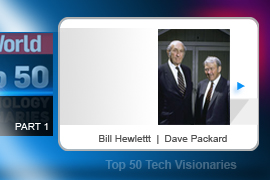
Bill Hewlett and Dave Packard
No company has touched so many facets of technology as the brainchild of Dave Packard (left) and Bill Hewlett. Originally responsible for building audio oscillators for Walt Disney in the 1940s, HP went on to create all manner of test equipment for electronics before jumping into computer servers, desktops, calculators, cameras, and of course printers.

Shigeru Miyamoto
The video game industry collapsed in the early 1980s, Shigeru Miyamoto almost singlehandedly kept the industry alive with his creation of an animated character named Jump Man, who soon became known as Mario. Miyamoto’s influence in the gaming business — he’s now a senior director of Nintendo — has been crucial ever since. His latest creation: Wii Fit.
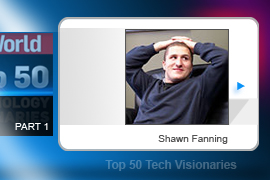
Shawn Fanning
With Napster, Shawn Fanning introduced the technology that, some doomsayers warn, could spell the end of the Internet. Today traffic from peer-to-peer programs consumes an estimated 70 percent of all broadband bandwidth.
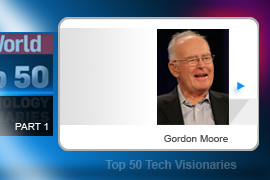
Gordon Moore
Moore’s Law, posited in 1965, three years before Gordon Moore founded a little company called Intel, predicted that the number of components on a computer chip would double every year (later, he amended it to every two years).

Bill Atkinson
His early ideas regarding user interface design elements like the menu bar became graphical user interface standbys not just on Apple computers (where he worked), but on every major operating system that has followed. As a programmer, Atkinson designed MacPaint, QuickDraw, and HyperCard.
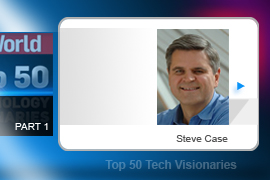
Steve Case
The brainchild of Steve Case, America Online pioneered more than just the chat rooms for which it became infamous. Case launched Neverwinter Nights — one of the first MMOs (massively multiplayer online games) — and (most notoriously) started the blending of online and big media by selling out to Time Warner in 2001.
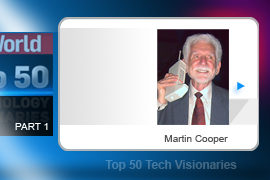
Martin Cooper
Whether you’re toting an iPhone, a Razr, or an enV, you owe a debt to Martin Cooper and his 1973 patent responsible for the mobile phone as we know it. His invention, created during his tenure at Motorola, weighed just shy of 2 pounds, and ten years would pass before mobile phones broke the 1-pound barrier.
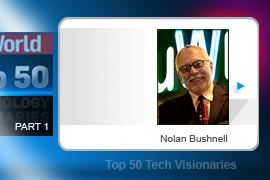
Nolan Bushnell
Atari is synonymous with video gaming — so much so that the name remains in use (though now far removed from founder Nolan Bushnell, the undisputed father of video gaming) 36 years after it originated. Bushnell’s inspiration — a world where everyone could play games in the comfort of their own home — is a rare instance where the vision panned out almost exactly as envisioned.
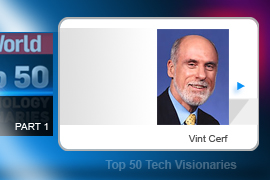
Vint Cerf
Cerf’s work as an Internet pioneer has largely taken place in universities and government agencies, which in the early 1970s led directly to the creation of ARPANet, the predecessor to today’s Internet. Cerf now works for — who else? — Google.
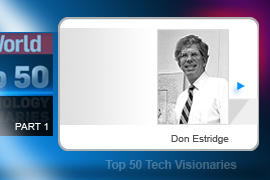
Don Estridge
Don Estridge is widely known as “the father of the PC,” at least in its Big Blue incarnation. Estridge lead a “skunk works” staff of just 14 people that ultimately produced the IBM PC, an “open” platform that could run third-party software and accept third-party upgrades, that would become the standard for business.

Michael Dell
Michael Dell started his company, PC’s Limited, at age 19 out of his dorm room at the University of Texas. Eventually he dropped out of school to found Dell Computer, which grew at breakneck pace throughout the 1990s, thanks to a marketing philosophy that revolutionized the industry.
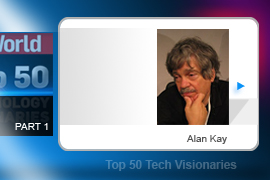
Alan Kay
Alan Kay created HP’s original Dynabook, one of the first usable mobile laptop computers. Kay’s contributions to software — which include shepherding the idea of object-oriented programming and the notion of multiple, overlapping windows in a GUI — rank as essential milestones in computing.

Marc Andreessen
Bits and pieces of Andreessen’s Mosaic web browser’s code remain standard software components of most of today’s commercial browsers. It’s a safe bet that one of Andreessen’s other creations will leave similar legacies: Netscape, the company he founded, set off the tech stock craze of the 1990s.

Linus Torvalds
Given the exorbitant cost of most Apple computers, Linus Torvalds is the godfather of what may be the last, best hope for an affordable alternative to Windows. The Linux operating system has experienced steady gains in popular acceptance every year since Torvalds conceived it in 1991.
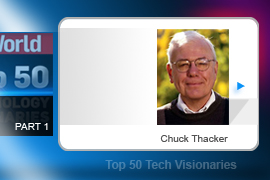
Chuck Thacker
Chuck Thacker has had his hands in a surprisingly wide array of tech projects, from the development of ethernet to the first laser printers. His most enduring legacy, however, involves a product that never reached market: The fabled Xerox Alto. The Alto, which Thacker designed, was the first computer with a GUI (and a mouse).
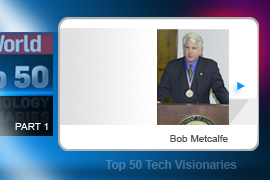
Bob Metcalfe
Moore’s Law may be better known, but the law formulated by Bob Metcalfe – 3Com founder and Ethernet inventor – has wider general application. Metcalfe’s Law conjectured that the value of a telecommunications network is equal to the square of the number of nodes on the network. This law is now in use to quantify value in the Facebook/MySpace milieu.
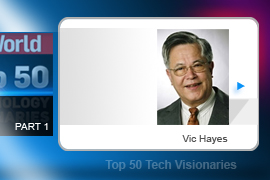
Vic Hayes
In 1990, Hayes formed the Wireless LAN working group and rallied some 130 companies to work together to develop open standards. The result: 802.11, and the cutting of a very firmly attached cord. Hayes continues to be actively involved in Wi-Fi development today.
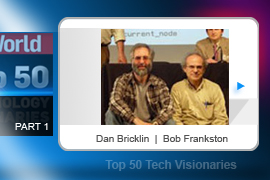
Dan Bricklin and Bob Frankston
Dan Bricklin (left) and Bob Frankston worked together in 1979 to develop VisiCalc, the world’s first spreadsheet and arguably the first “killer app” written for a personal computer. The 27KB program can run on PCs today, and its simplicity is a big reason why early PCs sold in droves.
❮ ❯




